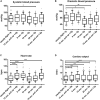Comprehensive Analysis of Macrocirculation and Microcirculation in Microgravity During Parabolic Flights
- PMID: 32903511
- PMCID: PMC7438475
- DOI: 10.3389/fphys.2020.00960
Comprehensive Analysis of Macrocirculation and Microcirculation in Microgravity During Parabolic Flights
Abstract
Background: Profound knowledge about cardiovascular physiology in the setting of microgravity can help in the course of preparations for human space missions. So far, influences of microgravity on the cardiovascular system have been demonstrated, particularly pertaining to venous fluid shifts. Yet, little is known about the mechanisms of these adaptations on continuous macrocirculatory level and regarding the microcirculation.
Methods: Twelve healthy volunteers were subjected to alternating microgravity and hypergravity in the course of parabolic flight maneuvers. Under these conditions, as well as in normal gravity, the sublingual microcirculation was assessed by intravital sidestream dark field microscopy. Furthermore, hemodynamic parameters such as heart rate, blood pressure, and cardiac output were recorded by beat-to-beat analysis. In these settings, data acquisition was performed in seated and in supine postures.
Results: Systolic [median 116 mmHg (102; 129) interquartile range (IQR) vs. 125 mmHg (109; 136) IQR, p = 0.01] as well as diastolic [median 72 mmHg (61; 79) IQR vs. 80 mmHg (69; 89) IQR, p = 0.003] blood pressure was reduced, and cardiac output [median 6.9 l/min (6.5; 8.8) IQR vs. 6.8 l/min (6.2; 8.5) IQR, p = 0.0002] increased in weightlessness compared to normal gravitation phases in the seated but not in the supine posture. However, microcirculation represented by perfused proportion of vessels and by total vessel density was unaffected in acute weightlessness.
Conclusion: Profound changes of the macrocirculation were found in seated postures, but not in supine postures. However, microcirculation remained stable in all postures.
Keywords: hemodynamic changes; microcirculation; microgravity; parabolic flight; weightlessness.
Copyright © 2020 Bimpong-Buta, Muessig, Knost, Masyuk, Binneboessel, Nia, Kelm and Jung.
Figures



Similar articles
-
Analysis of human microcirculation in weightlessness: Study protocol and pre-study experiments.Clin Hemorheol Microcirc. 2018;70(1):119-127. doi: 10.3233/CH-170366. Clin Hemorheol Microcirc. 2018. PMID: 29710687
-
Effect of gravity and microgravity on intracranial pressure.J Physiol. 2017 Mar 15;595(6):2115-2127. doi: 10.1113/JP273557. Epub 2017 Feb 14. J Physiol. 2017. PMID: 28092926 Free PMC article.
-
Spinal Stiffness in Prone and Upright Postures During 0-1.8 g Induced by Parabolic Flight.Aerosp Med Hum Perform. 2018 Jun 1;89(6):563-567. doi: 10.3357/AMHP.5031.2018. Aerosp Med Hum Perform. 2018. PMID: 29789091
-
Beat-to-beat agreement of noninvasive tonometric and intra-radial arterial blood pressure during microgravity and hypergravity generated by parabolic flights.Blood Press Monit. 2007 Dec;12(6):357-62. doi: 10.1097/01.mbp.0000209088.78235.59. Blood Press Monit. 2007. PMID: 18004103
-
The brain in micro- and hypergravity: the effects of changing gravity on the brain electrocortical activity.Eur J Sport Sci. 2014;14(8):813-22. doi: 10.1080/17461391.2014.908959. Epub 2014 Apr 15. Eur J Sport Sci. 2014. PMID: 24734884 Review.
Cited by
-
Countermeasures for Maintaining Cardiovascular Health in Space Missions.Curr Cardiol Rev. 2023;19(5):57-67. doi: 10.2174/1573403X19666230330083225. Curr Cardiol Rev. 2023. PMID: 37005513 Free PMC article.
-
Effects of weightlessness on the cardiovascular system: a systematic review and meta-analysis.Front Physiol. 2024 Jul 26;15:1438089. doi: 10.3389/fphys.2024.1438089. eCollection 2024. Front Physiol. 2024. PMID: 39129756 Free PMC article.
-
Choroidal circulation disturbance is an initial factor in outer retinal degeneration in rats under simulated weightlessness.Front Physiol. 2023 Jul 20;14:1198862. doi: 10.3389/fphys.2023.1198862. eCollection 2023. Front Physiol. 2023. PMID: 37546536 Free PMC article.
-
Computational modelling of cardiovascular pathophysiology to risk stratify commercial spaceflight.Nat Rev Cardiol. 2024 Oct;21(10):667-681. doi: 10.1038/s41569-024-01047-5. Epub 2024 Jul 19. Nat Rev Cardiol. 2024. PMID: 39030270 Review.
-
Cardiovascular Adaptations of Space Travel: A Systematic Review.Cardiology. 2023;148(5):434-440. doi: 10.1159/000531466. Epub 2023 Jun 10. Cardiology. 2023. PMID: 37302388 Free PMC article.
References
-
- Aratow M., Hargens A. R., Meyer J. U., Arnaud S. B. (1991). Postural responses of head and foot cutaneous microvascular flow and their sensitivity to bed rest. Aviat. Space Environ. Med. 62 246–251. - PubMed
-
- Baisch J. F., Wolfram G., Beck L., Drummer C., Stormer I., Buckey J., et al. (2000). Orthostatic stress is necessary to maintain the dynamic range of cardiovascular control in space. Pflugers Arch. 441 R52–R61. - PubMed
LinkOut - more resources
Full Text Sources

